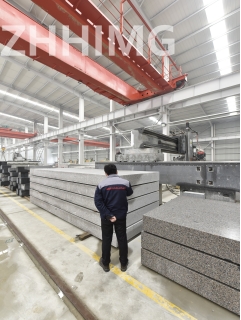Precision linear axis granite is a type of high-precision engineering tool used for linear motion applications and is made of high-quality granite material. It is designed to be stable and provide accurate movement for machines, tools, and equipment used in various fields of engineering and manufacturing. The precision linear axis granite has both advantages and disadvantages, and this article will explore some of them.
Advantages of Precision Linear Axis Granite:
1. High Precision: Precision linear axis granite provides high accuracy and precision in movement. This makes it ideal for use in applications that demand accuracy or require precise movement in manufacturing and engineering tasks.
2. Stability: The structure of precision linear axis granite is very stable and resists deformation from various external factors like temperature, humidity, and vibration. It offers excellent stability even in adverse conditions, making it a reliable tool for manufacturing and engineering processes.
3. Longevity: Precision linear axis granite has superior durability compared to other materials such as steel or aluminum. The natural properties of granite make it an ideal material to withstand wear and tear, thus offering long service life. This feature reduces maintenance costs and minimizes machine downtime.
4. Compatibility: Precision linear axis granite is readily adaptable to suit various machines and equipment. It is a universal tool that can fit into any system that requires linear motion.
5. Resistance to Corrosion: Granite is a non-porous material that is resistant to oxidation and corrosive substances. This makes precision linear axis granite ideal for use in environments that are hostile to other materials.
Disadvantages of Precision Linear Axis Granite:
1. High Cost: The cost of precision linear axis granite is considerably higher compared to other materials. This can be a significant drawback for companies that plan to use the tool.
2. Heavyweight: Precision linear axis granite is heavy, and this makes it cumbersome to handle. It requires special equipment and techniques to move it around, which can be a challenge in certain settings.
3. Brittle: Although granite has superior durability, it is still susceptible to damage from impact. Any crack or chip in the granite can render the tool unusable, which can cause interruptions in the manufacturing process.
4. Limited Availability: Precision linear axis granite is not readily available in all parts of the world. This can make it difficult to source for companies operating in remote areas.
5. High Maintenance Cost: While the tool has a long service life, it requires frequent calibration and maintenance to maintain its high level of accuracy. This can add up to maintenance costs, which can be a considerable challenge for companies.
Conclusion
Precision linear axis granite is a high-quality engineering tool that comes with several benefits and drawbacks. Its high level of accuracy, stability, and durability makes it a popular choice for engineers and manufacturers alike. However, its high cost, heavyweight nature, brittleness, limited availability, and high maintenance costs should be considered before deciding to invest in this tool. Overall, precision linear axis granite is an essential engineering tool that can significantly improve manufacturing and engineering processes' quality and efficiency.
Post time: Feb-22-2024

